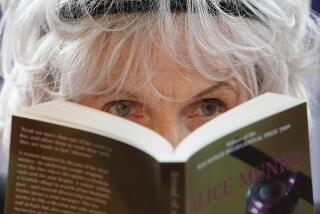Book Review : An Innocent Aussie Meets the World
- Share via
A House of Trees by Joan Colebrook (Farrar Straus & Giroux: $18.95; 252 pages)
As a girl growing up the high rain forest of Northern Australia in the 1920s, Joan Colebrook lived far enough away from the world so that she saw it as few of us can: as a distant configuration, unknown and yet, just because of the distance, as clearly outlined as an approaching thunderhead.
On certain afternoons, her family, hard-working settlers with a touch of expansiveness, sat on the veranda of their piling-built house and marked the approach. Tea was set out, and a sponge cake baked over the aromatic native wood, and after a while came a tiny tooting and a line of smoke in the distance, signaling the path of the train with its gray canvas mailbags.
“So the news of the world arrived,” Colebrook writes in her memoir, “not in great headlines or in the loud voices of modern communication but slowly, slowly, over the vast oceans from England, creeping up from the south of Australia by boat, and inching along in the small train that crossed the coastal strip, negotiated the steep ravines and the spidery railway bridges, and at last, like some brave panting animal, mounted steadfastly to our own northern plateau. . . .”
From the Farms to the Sea
It was a day’s journey from the misty farms of the Atherton Tableland down to the sea, but the trip simply exchanged one magic kingdom for another. The shores of the Great Barrier Reef, a teeming womb of the world’s marine life, were as strange and remote as the purple forests above. Colebrook remembers watching a duel between a swordfish and a shark, and puttering in a little boat among clams that stood six feet high.
To go down to the world, properly speaking, as Colebrook and her sisters eventually had to do, was a four-day train ride to the provincial capital of Brisbane. Not a metropolis, exactly, but the nearest exemplar of urban complexity and formlessness, offering such contrast to the concrete simplicities of life on the plateau. “A House of Trees” is about the distance.
Lost childhoods are the best and worst of educations. Best, because they nurture a kind of identity that is never really effaced. Worst, because the identity can leach belief from everything encountered later. “House of Trees” begins in a kind of golden clarity and ends--Colebrook is married and about to leave Australia--in a kind of dream.
In the highlands, life was only a generation removed from a terrible pioneer ordeal that carved farmland out of forest, and dealt with monsoons, deprivation, brutal treks and cannibalism. One of Colebrook’s uncles recalled seeing a potful of smoked human remains in a backland settlement. Colebrook’s parents, enlightened and civilized, still worked back-breaking days to maintain what was always a struggling existence, one that eventually foundered in the Great Depression.
There were books, games and sometimes visitors. Colebrook’s father was an idealist--a Royalist-turned-Puritan, she calls him--who was a leader in the community and dabbled, unsuccessfully, in politics. Her mother never stopped working and never let work get the best of an innate graciousness. But under it all, there was the intractability of the chore to be done.
The early chapters of “House” give a vivid picture of the upland life, of the settler tales, of the warmth of a large family, and of the trips Colebrook took with her father.
She went to the local school for a while, and later to an amiable but loftier Church of England school in the highlands. She read voraciously but she couldn’t base a sense of reality upon her books: The tasks were always there. She recalls going into the harness-room and being touched by the living quality of the rows of saddles, the battered hats, the mud-stained boots.
“These things were the manifestations of life, but where was the life itself?” she writes. “I could only think that life was a part of the things I looked at and touched; that life was mostly action; that life was a kind of courage.”
Getting an Education
But how to put such a vision to work, four days to the south in Brisbane? Colebrook and her sisters finished their high school there as boarders, and there are familiar accounts of dances and picnics and schoolgirl crushes. College was harder; the author was used to a kind of impulse reading; she had no idea how to study, and eventually she flunked out.
By that time--the mid-1930s--economic conditions were making things harder for her family. She moved into a boarding house, worked briefly and unsuccessfully on a local newspaper, and took a dispiriting job selling medical supplies to doctors. She felt invisible; the world, which had been small but tangible, now seemed enormous and elusive. An affair with a married man whom she met on the ferry commuting to work only increased her sense of unreality.
Colebrook’s writing seems to lose substance as she goes on. The married man, who appears to have loved her deeply--years later, she writes, he tried to find her in the United States--is a shadow. Even more shadowy is the young American diplomat who courted and married her. They have a baby and, at the end of the book, are departing for a post in London.
She writes of their life together, at this stage, as happy; she tells of outings and celebrations. None of it is nearly as real as the mud-stained boots in a row on the Atherton Tableland. It is as if the lost childhood had encircled the life; as if the approaching thunderhead, once entered, was nothing but mists.
More to Read
Sign up for our Book Club newsletter
Get the latest news, events and more from the Los Angeles Times Book Club, and help us get L.A. reading and talking.
You may occasionally receive promotional content from the Los Angeles Times.









